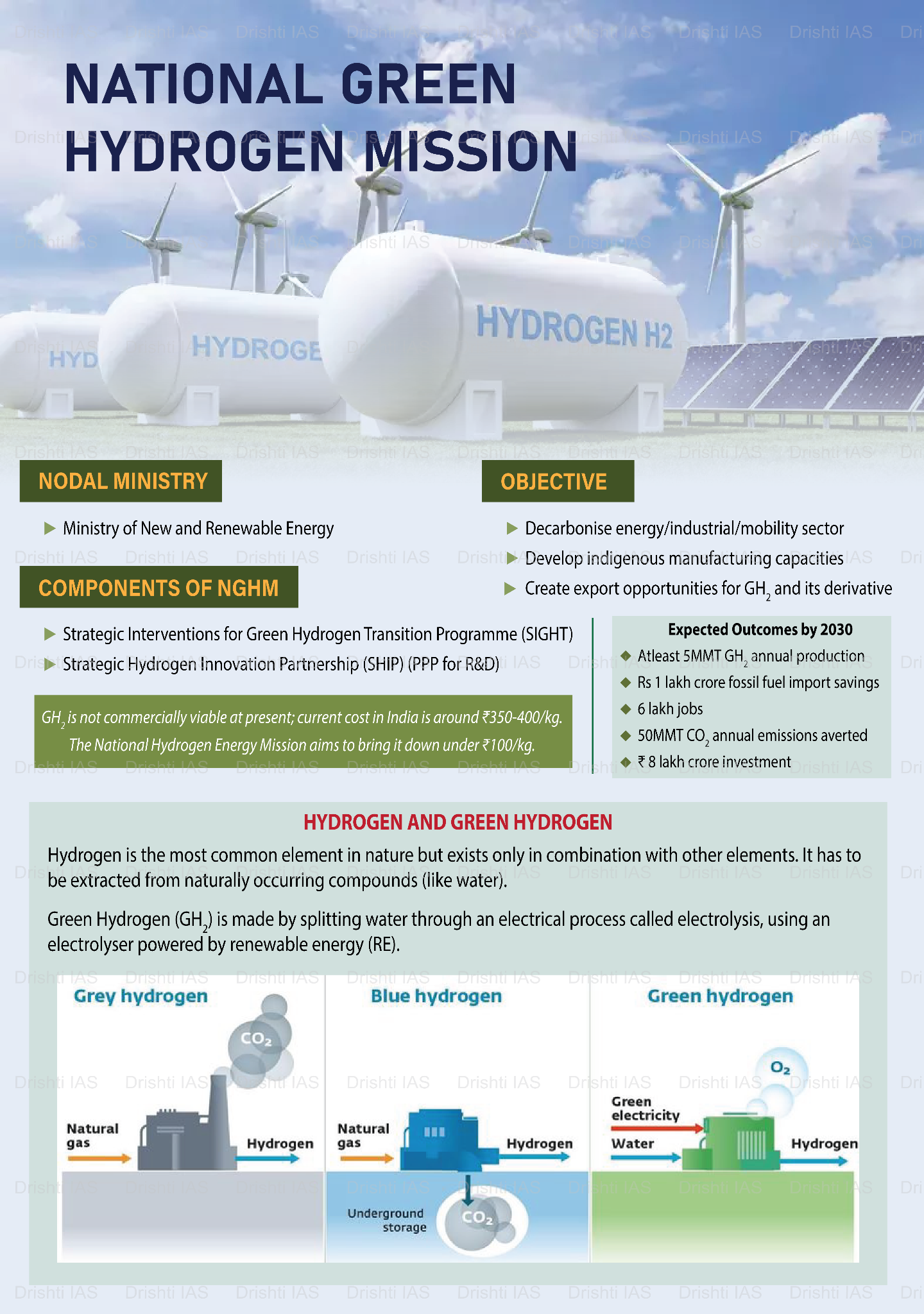Important Facts For Prelims
India Sets Emission Threshold in Green Hydrogen Standard
- 22 Aug 2023
- 4 min read
Why in News?
The Ministry of New and Renewable Energy (MNRE) recently defined a clear Green Hydrogen Standard, which establishes emission thresholds for hydrogen production categorized as 'green'.
- This significant development positions India at the forefront of global efforts towards sustainable energy solutions.
What is Green Hydrogen, and its Emission Threshold?
- Definition of Green Hydrogen:
- “Green Hydrogen” shall mean Hydrogen produced using renewable energy, including, but not limited to, production through electrolysis or conversion of biomass.
- Renewable energy also includes such electricity generated from renewable sources which is stored in an energy storage system or banked with the grid in accordance with applicable regulations.
- “Green Hydrogen” shall mean Hydrogen produced using renewable energy, including, but not limited to, production through electrolysis or conversion of biomass.
- Emission Threshold :
- The MNRE has determined that Green Hydrogen should have a well-to-gate emission of not exceeding 2 kg carbon dioxide (CO2) equivalent per kg Hydrogen(H2), taken as an average over the last 12-month period.
- The well-to-gate emission includes water treatment, electrolysis, gas purification, drying and compression of hydrogen.
- Methodology and Monitoring:
- The MNRE will specify a detailed methodology for measuring, reporting, monitoring, on-site verification, and certification of green hydrogen and its derivatives.
- The Bureau of Energy Efficiency (BEE), Ministry of Power, will serve as the Nodal Authority for accrediting agencies overseeing monitoring, verification, and certification of green hydrogen production projects.
- The MNRE has determined that Green Hydrogen should have a well-to-gate emission of not exceeding 2 kg carbon dioxide (CO2) equivalent per kg Hydrogen(H2), taken as an average over the last 12-month period.
What are India's Initiatives to Promote Green Hydrogen?
- National Green Hydrogen Mission:
- India launched the National Green Hydrogen Mission with the objective of producing 5 million metric tonnes of green hydrogen annually by 2030.
- The mission aligns with a target of about 125 gigawatts of associated renewable energy capacity.
- The program offers financial incentives to promote domestic production of electrolysers and green hydrogen.
- These incentives are designed to facilitate rapid scale-up, technology development, and cost reduction.
- Green Hydrogen Consumption Obligations:
- The MNRE has proposed to introduce green hydrogen consumption obligations for fertilizer and the petroleum refining industry, like the renewable purchase obligations for electricity distribution companies.
- The obligations will require these industries to consume a certain percentage of green hydrogen in their total hydrogen consumption.
- The MNRE has proposed to introduce green hydrogen consumption obligations for fertilizer and the petroleum refining industry, like the renewable purchase obligations for electricity distribution companies.
UPSC Civil Services Examination, Previous Year Question (PYQ)
Q. Consider the following heavy industries: (2023)
- Fertilizer plants
- Oil refineries
- Steel plants
Green hydrogen is expected to play a significant role in decarbonizing how many of the above industries?
(a) Only one
(b) Only two
(c) All three
(d) None
Ans: (c)
Need for Producing Green Hydrogen:
- Green hydrogen in particular is one of the cleanest sources of energy with close to zero emission. It can be used in fuel cells for cars or in energy-guzzling industries like fertilizers and steel manufacturing.
- Green Hydrogen can aid the desulfurisation of crude oil, without the output of CO2 into the atmosphere hence it can provide a clean, on-site green hydrogen supply which will decarbonise the refining process and reduce emissions.
- Hence option (c) is correct.
Q. With reference to green hydrogen, consider the following statements : (2023)
- It can be used directly as a fuel for internal combustion.
- It can be blended with natural gas and used as fuel for heat or power generation.
- It can be used in the hydrogen fuel cell to run vehicles.
How many of the above statements are correct?
(a) Only one
(b) Only two
(c) All three
(d) None
Ans: (c)





